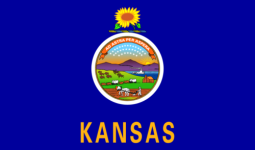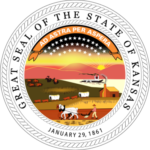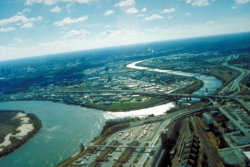Kansas
Kansas is a U.S. state located in the Midwestern United States. Kansas is bordered by Nebraska on the north; Missouri on the east; Oklahoma on the south; and Colorado on the west. The state is located equidistant from the Pacific and Atlantic oceans.
- ABBREVIATION: KS
- NICKNAME: The Sunflower State
- POPULATION: 2,893,957 (2013 est.)
- CAPITAL: Topeka
- STATE BIRD: Western Meadowlark
- STATE FLOWER: Sunflower
- AREA: 82,277 sq. mi.
- TIME ZONE: Most of state Central, – 4 western counties Mountain
- ENTERED UNION: Jan. 29, 1861
- ALTITUDE: High, 4,041 ft. Mount Sunflower
- CLIMATE: Cold winters, hot summers; moderate rainfall in east, diminishing in west.


Like its neighboring landlocked states, far from the moderating, moisture-laden winds of the coasts, Kansas is either extremely hot or extremely cold. And it is forever at the mercy of the wind. Unprotected by peripheral mountain ranges, the land is swept by artic gusts in winter and furnace-hot blasts in summer. When the wind is gentle, the effect is lovely; slender stalks of wheat, which march row upon row across the plains, rise and dip before the breeze like waves on the sea. But sometimes the wind blows so hard that the soil itself is removed. In the 1930’s, before conservation methods were widespread, southwestern Kansas was part of the tragedy-strewn Dust Bowl.
On a typical Kansas farm the chief crop is wheat. But as a protection against the hazards of searing summer heat and irregular rainfall many farmers also raise cattle. Kansas ranks third nationally with 5.80 million cattle on ranches and in feed-yards (2014 est.), that’s a little over twice the current human population. To be profitable in an area where the scarcity of rain may limit the yield per acre, and where a portion of the land must be left to lie fallow each year so that it can absorb moisture, Kansas farms are necessarily large. With over 64,000 farms, the average size is approximately 732 acres.

To early explorers, Kansas seemed “uninhabitable by a people depending on agriculture”. But in 1874, when Mennonites from southern Russia planted Turkey red, a strain of wheat which had flourished on the Russian steppes, men discovered Kansas’ destiny. Today, Kansas, which is 90% farmland, grows nearly 20 percent of total domestic production of wheat, on average more than any other state, with annual farm gate receipts of nearly $3 billion.
FUN FACTS:
- So many fossils were found in Kansas in the late 1800s that competing paleontologists launched the ‘Kansas Fossil Wars’, resorting to bribes and trickery to get the best specimens.
- In 1990 you could have made 33 billion loaves of bread with the amount of wheat produced by Kansas wheat farmers. That equated to 6 loaves for each person on Earth.
- In 1938 Pizza Hut, one of the world’s largest pizza companies, opened its first restaurant in Wichita.
- Dry air and a constant temperature of 68.5 degrees in the underground chambers of an old salt mine near Hutchinson make them ideal for storing valuables, including thousands of original Hollywood movies.
- Barton County is named for Clara Barton, famed Civil War nurse and founder of the American Red Cross.
- Samuel Perry Dinsmoor used 113 tons of concrete to create the Garden of Ede, in Lucas, Kansas. Visitors can still see Dinsmoor, who died in 1932. He lies in a concrete tomb with a glass top.
